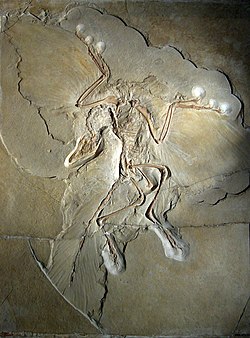Archaeopteryx
genus of early bird-like dinosaur From Wikipedia, the free encyclopedia
Remove ads
Archaeopteryx is one of the most important creatures ever discovered. It is a flying dinosaur from the end of the Jurassic Period, about 150 million years ago. It shows the evolutionary link between non-avian theropod dinosaurs and birds, but it is not the ancestor of modern birds.[2]

The first male Archaeopteryx specimen was found in 1860 near Solnhofen in Bavaria, Germany. Today, ten skeletons and one feather of Archaeopteryx have been found.[3]
Archaeopteryx was a small and dangerous dinosaur with feathers and wings. It had a mouth with teeth, claws on the hands and a long tail. Today, it is known that dromaeosaurs, and possibly most other extinct theropods, looked like birds and that many had feathers. When they are born, today's South American hoatzin have claws on their wings when they are young, just like the prehistoric Archaeopteryx.
Remove ads
Analysis
Thomas Henry Huxley ("Darwin's bulldog"), who was a comparative anatomist, made a study of this nearly 150 years ago. He compared Archaeopteryx with a small theropod dinosaur, Compsognathus. Both of the fossils came from the same place: Solnhofen in Bavaria, Germany. The strata come from the end of the Jurassic period, about 144 million years ago. He showed that both were very similar except for the front limbs and feathers of Archaeopteryx.[4] E.D. Cope also came to the same conclusion.[5]
Huxley's study showed the basic relationship between birds and reptiles. He united them under the title of Sauropsida. His papers on Archaeopteryx and the origin of birds have been of great interest ever since. Huxley concluded that birds evolved from small carnivorous dinosaurs.[6][7]
Remove ads
Status today
Archaeopteryx used to be considered the first bird. Nowadays, it is not the only fossil of a bird-like dinosaur. A similar species called Anchiornis huxlei lived from 160 to 155 million years ago.[8] It had feathers on both front and rear legs, and could probably glide. It may or may not have had some ability to fly. This discovery means we cannot say Archaeopteryx is the first known bird, but its contribution to science has been huge. We now know for sure that a whole group of small theropod dinosaurs had feathers, and that flight was a later, secondary, use of feathers. The first use of feathers was temperature regulation, and probably also signalling to females of the species (see Epidexipteryx).
Many scientists nowadays do not consider Archaeopteryx a true bird (=a member of the lineage Aves). They only consider it a relative of birds. This classification does not reflect a different evolutionary hypothesis, it simply defines Aves (birds) less broadly.[9]
Directly ancestral or not?
It may be that Archaeopteryx is not directly ancestral to modern birds, but it is still a fine transitional fossil.
- "Archaeopteryx, for example, is not necessarily directly ancestral to birds. It may have been a species on a side-branch. However, that in no way disqualifies it as a transitional form, or as evidence for evolution. Evolution predicts that such fossils will exist, and if there was no link between reptiles and birds then Archaeopteryx would not exist, whether it is directly ancestral or not".[10]
Remove ads
Related pages
Further reading
- Chambers P. 2002. Bones of contention: the fossil that shook science. London: John Murray. ISBN 0-7195-6059-4
- Shipman P. 1998. Taking wing: Archaeopteryx and the evolution of bird flight. London: Weidenfeld & Nicolson. ISBN 0-297-84156-4
In popular culture
Archaeopteryx has appeared in a few media, including the comic series Rip in Time. In a chapter issue of the series, an aggressive female individual is shown nesting. Rip Scully makes a bow and arrow from his pocket knife, and kills her. Later, he cooks her around a fire.
References
Wikiwand - on
Seamless Wikipedia browsing. On steroids.
Remove ads

